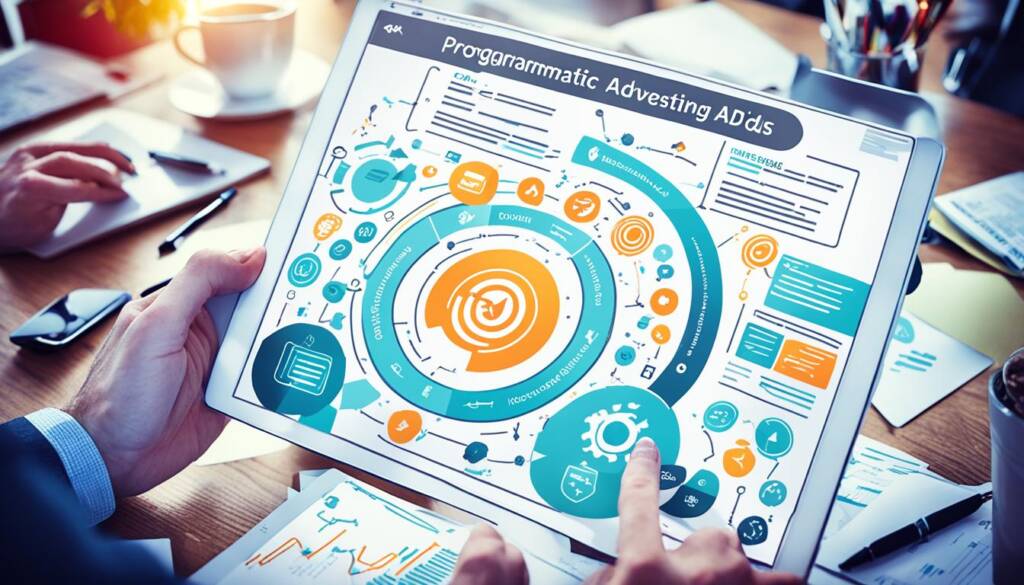Programmatic advertising is a new way to buy and sell ad space, led by companies like Web AI Engine. It uses data and algorithms to make these transactions automatic. This means ads get shown to the right people at the best time and price, making online ads more effective.
Before, buying ads was slow and manual. Now it’s fast and precise. Web AI Engine uses advanced technology to help marketers quickly and accurately target their audience. This new way of advertising is all about speed and making sure ads reach the right people.
It uses real-time bidding (RTB) to show ads instantly. This makes the ad market more lively and competitive1. Programmatic advertising also cuts down on wasted ads and reduces the chance of fraud, making it a smart choice2.

Key Takeaways
- Programmatic advertising automates the media buying process through data insights and algorithms.
- Real-time bidding (RTB) technology allows for instant ad display and participation in auctions.
- Platforms like Web AI Engine leverage GPT-based technology for rapid and precise advertising solutions.
- This approach enhances the efficiency and effectiveness of digital marketing strategies.
- Automation through programmatic advertising reduces wasted impressions and ad fraud risks, making it cost-efficient.
Understanding Programmatic Advertising
It is a new way of buying ads online. It uses smart software and algorithms for real-time bidding on many websites at once. This makes buying ads fast and precise3.
What is Programmatic Advertising?
This is a way to buy ads automatically through real-time auctions. Advertisers use special platforms to show ads to people who are likely to be interested. For example, Web Ai Engine uses algorithms to match ads with the right people, making campaigns more effective. This is different from old ways that relied on manual deals and sales.
Key Components Involved
Programmatic advertising needs several important parts to work. Advertisers use demand-side platforms like The Trade Desk to buy ads. Publishers sell ad space through supply-side platforms such as Google Ad Manager. Ad exchanges, like Google Ad Exchange, help these platforms talk to each other efficiently. This way, advertisers can reach lots of people without spending too much, with costs between $0.50 and $2.00 per thousand views4.
Advanced artificial intelligence and machine learning also play a big role. They help predict what people might like and tailor ads for them. This means ads can change in real-time to get better results3.
Traditional vs. Programmatic Media Buying
Old ways of buying ads were slow and needed a lot of manual work. They didn’t allow for quick changes based on new data. Programmatic buying is faster and more flexible. Advertisers can change their ads to target the right people instantly. This has changed digital marketing by making campaigns more effective and efficient4.
Here’s how traditional and programmatic buying compare:
| Aspect | Traditional Media Buying | Programmatic Media Buying |
|---|---|---|
| Process | Manual negotiations | Automated real-time auctions |
| Data Usage | Limited data application | Extensive real-time data analysis |
| Speed | Slow and inflexible | Fast and adaptable |
| Audience Targeting | General targeting | Precision targeting and optimisation |
Benefits of Programmatic Advertising
Programmatic advertising has many benefits, like reaching a huge audience. It uses millions of websites to connect with people from all walks of life. By 2024, it’s expected to take up 75% of global ad spending, showing its huge impact5. This makes it a key player in digital ads, covering over 82% of digital ad spending5.
It’s great for making ads more effective by using real-time data. Marketers can quickly change their campaigns to get better results. This means they can make smart choices fast, improve their ads, and reach the right people6. It also lets companies spend their ad money wisely, fitting it to their needs and goals6.
Using first-party data makes targeting much better. Brands use their own data to hit the right audience, making ads more relevant. This means ads are more likely to grab attention and work well6.
Programmatic ads can reach people across different devices and platforms. This includes audio, TV, online billboards, and more5. Being everywhere helps brands get noticed more and makes it easier to find new customers5. The Web AI Engine boosts these efforts by using smart technology to improve ad results.
Being open about how ads work is a big plus of programmatic advertising. Marketers get to see where their ads go, who sees them, and how well they do6. This is made possible through preferred deals and private marketplaces, which help advertisers and publishers work better together7.
Programmatic advertising is also very efficient. By 2028, it’s expected to make up 81% of digital ad revenue6. A study by Nielsen found it improved campaign reach by 11% across 10 campaigns, showing its effectiveness6. All these points highlight how programmatic advertising is a powerful tool for today’s marketers.
Conclusion
Programmatic advertising is changing the game in digital ads. It’s a big step forward for the future of advertising. With programmatic display ads growing by 15.9% and video ads by 20.9% in 2024, digital ads are getting more dynamic8.
Companies like Web Ai Engine are leading this change. They use AI to make ads more personal and run campaigns well. The rise of podcast ads, expected to hit $4 billion by 2025, shows how targeted ads are becoming key8. This means ads match what people want more closely.
Real-time bidding, direct buying, and private marketplaces are changing how ads are bought and shown. They give advertisers better control and accuracy9. As programmatic ads grow, using these new ways is vital. They help businesses cut waste and get more from their ads9. So, adding programmatic ads to marketing plans is key to staying ahead in the digital world.
Source Links
- https://advertising.amazon.com/en-gb/blog/programmatic-advertising
- https://www.adjust.com/glossary/programmatic-media-buying/
- https://www.outbrain.com/blog/programmatic-advertising/
- https://www.searchenginejournal.com/what-is-programmatic-advertising/462655/
- https://bullseyestrategy.com/blog/benefits-of-programmatic-advertising/
- https://www.impactmybiz.com/blog/benefits-of-programmatic-advertising/
- https://www.adjust.com/blog/programmatic-advertising-explained/
- https://incivus.ai/the-state-of-programmatic-advertising-in-2024/
- https://improvado.io/blog/what-is-programmatic-advertising



